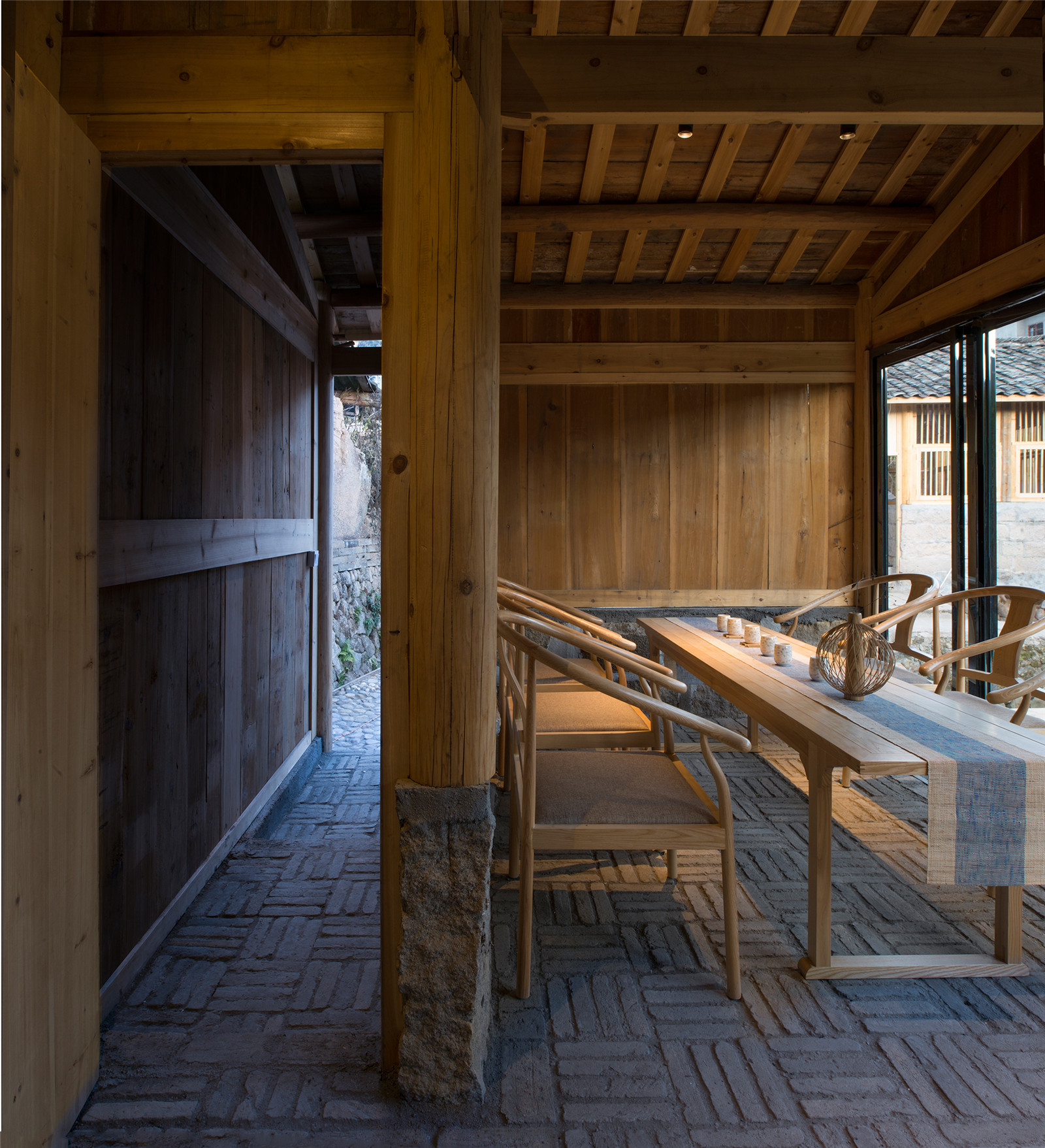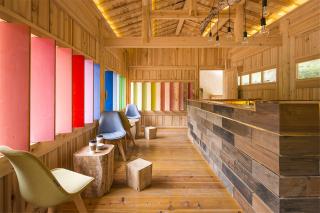福建上坪古村复兴计划 | 三文建筑
-
项目名称:上坪古村复兴计划
-
项目地点:福建省三明市建宁县溪源乡
-
项目规模:水口区域159平方米、杨家学堂113平方米、大夫第151平方米
-
设计公司:
-
委托方:溪源乡人民政府
-
建成时间:2016年11月至今
-
图片来源:周梦、金伟琦、日月蓝草
上坪村,地处福建省三明市建宁县溪源乡,是中国传统村落,福建省历史文化名村。上坪村自宋代建村,文化底蕴深厚,大部分村民为杨姓,至今仍保留宗族单元,是客家山村、客家宗族文化的典型代表。村庄空间格局完整,两条溪流绕村,并在村口汇聚,形成完整的风水格局;现存建筑多为明清时期民居,村中有多处建宁县文物保护单位,如杨氏家庙、社祖庙等;此地耕读传统浓厚,据传著名教育家朱熹也曾在此地讲学,并留下墨宝。然而随着现代交通的变更及传统产业的衰败,上坪村人口流失情况严重,传统技艺面临失传的危机。上坪古村的发展处于一个前所未有的关键时刻,或由于村庄缺乏活力和公共生活进一步没落,或可成为探索古村落复兴新模式的契机。
Proclaimed as a Traditional Village of China, Shangping Village lies in Xiyuan Township, Sanming City, Fujian Province of southeast China. The village was founded in the Tang Dynasty and has developed rich cultural traditions. Today, as an exceptional representative of Hakka villages and Hakka clan culture, it still remains a clan-based lineage community, with most dwellers surnamed Yang, featuring a well-developed layout designed on the basis of the Chinese Fengshui geomancy philosophy. Most existing buildings in the village are folk houses built during the Ming and Qing dynasties, several of which are proclaimed as historic monuments under county-level protection. “Schooling while farming” is a deep-rooted tradition that has long been practiced in the village. In modern times, however, decline of traditional industries have led to emigration of village population and threatened transmission of traditional skills. At this unprecedented tipping point, Shangping Village is faced with a critical choice: either continuing to decline due to lack of vitality and public life, or embracing an opportunity to seek a new model of revival.
▼上坪古村航拍
Aerial View ©金伟琦

本次改造设计旨在为古村注入活力、改善民生、并为古村提供新的产业平台;进一步重塑古村落社区形态、传承低技的传统建造技艺、增强宗族联系与社区认同感、建立历史保护与当代需求、本地传承与外部介入的纽带,从而实现古村落在形式及功能上的适应性转变,形成古村落复兴的新模式、为中国的各地乡村复兴提供参考。
The restoration projects aimed at reinvigorating the historic village, improving villagers’ livelihood and creating new industries; reshaping the village community, transmitting traditional building skills, enhancing clan ties and community identity, and building links between heritage protection and contemporary needs, local transmission and external involvement; and thus achieving adaptive transformation in both form and function, developing a new model of revitalizing historic villages and setting an example that can be drawn upon by the rest of the country.
▼上坪古村水口区域航拍
View of Shuikou area ©金伟琦

作为试点的三个节点分别为水口区域、杨家学堂区域和大夫第区域,水口区域的建成建筑包含供休憩及祭拜的廊桥、烤烟房艺术装置以及杂物棚改造的“彩云间”咖啡厅;杨家学堂区域包含供本地人阅读的乡村图书馆“静雅”及面向游客的乡村书吧“广悦”,两栋建筑均改造于牛棚与杂物间;大夫第区域包含猪圈改造而成的“圈里”酒吧、杂物棚改造的茶室“莲舍”、“圈外”会议室以及原本用于放置农业设施笋榨、如今作为重要开放与体验空间的棚架广场。
The three pilot sites are Shuikou Area (known as the entrance of the village), Yang’s School Area and Tai Fu Tai Mansion Area . Restored buildings in Shuikou Area include Gallery Pavilion that offers a space for recreational activities and sacrificial rites, Art Installation in Tobacco-curing House, and Clouds Café that was remodeled from a utility shed. Jingya Granary Library that is open to local villagers and Guanyue Granary Bookstore that offer reading service to tourists, within Yang’s School Area, were both remodeled from cowsheds and utility rooms. Restored buildings in Tai Fu Tai Mansion Area include Quanli Pigsty Bistro remodeled from a pigsty, Lotus Chamber, a teahouse remodeled from utility rooms, Quanwai Orchard Conference Room, and two wooden canopies that was originally used to store agricultural equipment and has been re-designed as a major open experience space.
▼上坪古村水口区域改造后全貌
Panorama view of Shuikou area in Shangping Village ©金伟琦

▼杨家学堂概貌
View of Yang’s School Area © 三文建筑

▼大夫第区域鸟瞰
Aerial View of Tai Fu Tai Mansion Area

在建筑风格上,不刻意复古而是因地制宜,在在地性、乡土性的基础上,强调当代性、艺术性和趣味性。此外,在空间营造的基础上,强调后续的有效经营和与原有农业和手工艺的结合,乡村文创产品的跟进,以及相关的宣传推广,形成从产业规划到空间营造,再到旅游产品和宣传推广的融合设计。
设计师利用上坪古村原有的文化历史传说、传统进行乡村文创,打造一系列专属于上坪古村的乡村文创产品和旅游纪念品。如利用朱熹的墨宝对联创作的书签,笔记本;提取上坪古村的历史、文化、建筑、农业特点设计的上坪古村的logo,以及由此延伸的文化衫,雨伞等。在大夫第节点,除了特别为上坪莲子、笋干设计的包装外,一个由“圈里”酒吧衍生出来的以“猪”为主题的系列产品显得尤为突出。猪在中国传统中是富足的象征,在汉字中“家”字下面的“豕”字就是猪的意思,在西方文化猪也有吉祥、幸运的意思。设计师以猪为造型设计了一组产品,包括:丝巾、杯垫、明信片等等,它们一方面对应建筑的原始用途,另一方面又增加了趣味性。这些文创产品既传承了上坪古村的历史文化,又为村庄旅游提供收入。
In terms of architectural design, contemporary, artistic and interesting features were highlighted on the basis of the site-specific and indigenous nature of village buildings and settings. In addition, space design was focused on integrating original agricultural and handicraft elements into after-restoration business operation and developing creative products and marketing strategies. It is an integrated process of architectural design, involving industrial planning, space designing, tour package development, and market promotion.
Designers created multiple cultural products and souvenirs by taking advantage of history, legend and local materials. A good example is the design of notebooks and bookmarks, with couplets from Mr. Zhu Xi. The Logo of Shang Ping Village were designed with cultural, architectural and agricultural components. Other cultural projects, such as T-shirts and umbrellas, also derived from the logo. In Tai Fu Tai Mansion, besides the package design for Shang Ping lotus nuts and dried bamboo shoots, products with the theme of ‘pig’ for ‘Pigsty Bistro’ are also well designed. Pig represents affluence in China and also means lucky in western culture. In Chinese character, ‘family’ is composed with a ‘roof’ and a ‘pig’, which means praying underneath the roof makes a family complete. Using pig as the prototype of cultural products like scarves, coasters and post cards is to maintain the original taste of the rural buildings, thus making it an interesting project. All these products inherit great culture of Shang Ping Village as well as increase local income from tourism industry.
▼上坪古村文创产品:上坪莲子与彩云间咖啡
Shangping cultural and creative products: Shang Ping lotus nuts and coffee cups of Clouds Cafe ©金伟琦


▼上坪古村文创产品:手绘地图及印章
Shangping cultural and creative products: Hand-painted maps and seals ©金伟琦

改造后,上坪古村的三个节点区域已重建了公共空间和社区中心,对鼓励当地村民参与当地文化和公共活动起到了积极作用。
After restoration, these areas have re-established themselves as public spaces and community centers, effectively encouraging village residents to engage in cultural and public events.
▼廊亭
Gallery pavilion ©金伟琦

▼“广悦”书吧室内
Interior view of Guang-Yue Granary Bookstore

▼两处棚架被用于制笋空间和凉亭
Wooden canopies applied in a bamboo shoot squeezing space and a pavilion

上坪古村复兴计划之水口篇
Over the Rainbow: Shangping Village Regeneration - Shuikou Area
场地情况:位置重要,但状况急需改善
The site condition: vital location, but in urgent need of improvement
村口是古村的水口,也是村民祭拜祖先、神灵的地方。村口原有建筑包括:社祖庙、杨家祠堂、廊亭、以及烤烟房和杂物棚;古桥、玉兰树,荷塘是村口主要的景观元素,它们与古建筑一起构成了该区域的基本风貌。
The Shuikou area is the village entrance, as well as for worship activities to ancestors and divinities. The existing buildings include the Shezumiao Shrine, the Yang’s Ancestral Temple, a gallery pavilion, a tobacco-curing house and a debris shed. To integrate with the buidlings, an ancient bridge, a magnolia tree, and lotus ponds constitute the landscape elements.
▼廊亭
Gallery pavilion ©金伟琦

▼春日的廊亭
Gallery pavilion in springtime © 日月蓝草

廊亭
The gallery pavilion
将原有的封闭的毛石廊亭拆除,用木材重新塑造一个新的,更为通透的廊亭。它既要满足阻隔视线,锁住水尾的传统格局,又必须让坐在廊亭里的人可以看到周边的景色,过往行人。设计师在采用传统举架结构的基础上,对外立面进行了大胆的改良,利用格栅形成半通透的效果,并在半高的位置开了一条通长的“窗”,形成框景。这种形态乍看很现代,但细看又能从中看到唐宋时代中国建筑的影子,也从另一个角度回应了上坪村传说中可以追溯到宋代的历史。廊亭中当地居民自发供奉的神像被妥善的保留好,并重新安置回新建筑原有的位置上,设计师希望通过对原有信仰的尊重,使新廊亭与老廊亭建立一种传承关系,也让当地人更容易的接受这个村中的新成员。灯光的处理,进一步加强了廊亭作为村口精神性的符号功能。夜晚,从远方归来的村民可以在很远的地方就看到廊亭中的灯光,它引导着人们回家的方向。
It needs to tear down the original pavilion with rubbery stone and to build a new one with more transparent corridor. It not only maintains traditional feng shui pattern of blocking sight and water, but also provides the good view for people who are sitting inside the corridor appreciating the surrounding scene and passers-by. Designers audaciously amend the external wall and create a semi- permeability effect by use of grilling on the basis of the raising-of-truss structure and open a landscape "window" in the semi-high position which is very modernistic at first glance but we can carefully see the regulations of Chinese traditional architecture of Tang and Song dynasties. The designers wish to establish an inheritance through the respect of the original faith and enable the locals to accept the new pavilion that the statues of worship for local people are well preserved and re-placed back to the original position of the new building. The lighting design further strengthens the symbolic spirit function of the village: at night, the returning villagers can see the lights at a very distant place that leads the way home.
▼廊亭
Gallery pavilion ©金伟琦

▼雾气中的廊亭
Gallery pavilion in the mist ©金伟琦

▼廊亭内的鱼灯装置
Fish Lamps inside the gallery pavilion ©金伟琦


彩云间
Clouds Cafe
建在原来场地中杂物棚的基地上。它是一个不大的小房子,基本保持了当地的棚架的格局,半高架约1.5米,人在其间,可以从高处俯视面前的荷塘,从而完成村庄整体格局中的“观水”主题。建筑的功能是水吧,设计师希望它成为村口供人歇脚的场所。因为空间不大,所以内部格局不复杂,就是一个简单的方盒子。面向村庄的立面,采用了中轴的木窗板,使内外空间形成灵活多变的可能性。窗板并没有墨守成规,而是将一侧油漆成七彩的颜色,这样无论是远观,还是在室内,建筑都平添了一抹妩媚。设计师希望,这个新的服务设施能为古老村庄带来一点戏剧性的“冲突”。
Clouds Cafe is a small house built on the original debris shed while keeping the form of local pergola, from which people can look down the pond in front. Shaped as a box with simple interior, the function of the building has been designed as a cafe for both locals and tourists to have a rest. For the facade facing to the village, the designers have adopt the wooden windows, one of whose sides are painted in color while another in plain, with axis to make a flexible while charming internal and external space. The designers hope that this new service facility will bring a dramatic "conflict" to the ancient village.
▼ 彩云间立面变化
Facade transformation of Clouds Cafe ©金伟琦


▼彩云间:灵活多变的木窗扇立面
Clouds Café - transformable wooden windows ©金伟琦

▼彩云间室内
Clouds Café (interiors) ©金伟琦


烤烟房
The tobacco-curing house
作为当地农业的传统工艺遗存,烤烟房具有一定的旅游观赏价值,可以满足城市人对传统制烟工艺的好奇。但设计团队并不希望把改造工作停留在原有工法的简单再现上,一种艺术的手法被引入,通过一个光和色彩的装置,烤烟房被塑造成对中华农耕文明,及其紧密相关的太阳的歌颂。阳光被分解和强化为彩色的光,从天窗照入室内空间,奇幻的光影效果为简单的空间提供了浪漫的色彩。设计师希望这里成为一个仪式性的场所,通过反映太阳的艺术装置,现代人可以反思人与自然的关系。
As a relic of traditional agriculture facility, the tobacco-curing house has important tourism value for urban residents to learn about traditional tobacco-making craftsmanship. The design team did not want to make the transformation as a simple reproduction of the original techniques but an artistic intervention was introduced: The tobacco-curing house has been molded into an ode to farming civilization and sun through a lighting installation. The sunlight would be intensified into colored lights from the skylight window. Designers hope it becomes a ritual place for people to reconsider the relationship between man and nature by artistic installation.
▼烤烟房内部的彩虹艺术装置
Rainbow art installation inside the tobacco-curing house ©金伟琦





上坪古村复兴计划之杨家学堂篇
Yang’s School Rural Library and Bookstore
杨家学堂节点位于上坪村两条溪流的交汇处,是入村后的道路分叉口,地理位置非常重要。此处有杨家学堂,相传朱熹曾在这里讲学,并留下墨宝。选择在这个地点进行节点改造设计,既考虑了旅游人流行为的需要,也照顾到了上坪古村的历史文化。
改造对象是杨家学堂外面的几间废弃的农业生产用房。他们是:杂物间和牛棚和谷仓。设计团队希望将原来的建筑改造为一个书吧,一方面为外来的观光者提供一个休息和了解村庄历史文化的地点,更为重要的是为当地人,特别是孩子提供一个可以阅读,可以了解外面世界的窗口,并为重拾“耕读传家”的文化传统提供了支点。
Yang’s School Area is located at the intersection of the two streams in Shang Ping Village where two main trails dispatch from the entrance. That’s the reason of being important geographically. According to historical legend, Mr. Zhu Xi, a national historian and educationalist, has lectured in Yang’s School and created great poems as well as calligraphy here. The design of this part is to transform historical site into a tourist spot and unveil the great history of Shang Ping Village.
The design includes a few deserted agricultural buildings, such as utility rooms, cowsheds and barns. The design team hopes to transform the original buildings into a bookstore which provides space for tourists to learn about the history and culture of the village. Meanwhile, it also provides locals, especially children, with a place to get knowledge from the outside world. It is a great opportunity to indicate a well-known Chinese tradition called "Cultivation and reading is to bequeath to the family".
▼杨家学堂概貌
View of Yang’s School Area

▼杨家学堂夜景
Night view of Yang’s School Area

广悦与静雅
‘Guang Yue Granary Bookstore’ and ‘Jing Ya Granary Bookstore’
在前期的踏勘中,设计师发现现状的杂物间和牛棚在空间上有很大差异。杂物间相对高大,内部空间开放;而牛棚则正好相反,因为原有功能的需要,空间矮小,黑暗,几个牛棚之间由毛石分隔,此外牛棚上面还有一个低矮的二层用于存放草料。利用原有空间的特点,设计团队将新建筑定义为“一动一静”两个部分。
In the early phase of site analysis, designers found that utility room and cowshed are very different in terms of spatial identity. The utility room is relatively tall with accommodated interiors, while the cowsheds are lower and darker. Several cowsheds are separated by rubble walls and second floors are used for storing forage originally. By using the characteristics of the original space, the design team defined the new building as a combination of ‘Live and Calm’.
▼杨家学堂的新建筑分为“一动一静”两个部分
The new buildings embody interrelated qualities of dynamism (dong) and quietness (jing).

“一动”是利用杂物间改造的书吧的售卖部分,这里相对热闹,拿书借书,买水喝水,以及设计团队专门为上坪村创作的一系列文创产品都在这里集中展示、销售。这里是上坪村对外的一个窗口,外来人可以在这里阅读上坪古村的“前世今生”;村里人也可以透过物理性的窗口(建筑的朝向村庄一面采用了落地玻璃的方式,将书吧和村庄生活连着一起。)和心理的窗口和外面的世界进行对话。大家称之为“广悦”。
‘Live’ refers to the sales space in Boostore transformed by utility room. It is relatively active to be here when exchanging books and sales activities happen periodically. Also, cultural products designed by the team are sold at this corner. Reading Bar is regarded as a cultural window connecting the village to the world outside. Visitors can get to know more about the village while local residents see the outside from a physical window (a full height glass door facing to the village) and psychological one. It is called ‘Guang-Yue Granary Bookstore’.
▼ “广悦”书吧内就座区的溪流景观
The scene of the stream in the seating area of Guang-Yue Granary Bookstore

▼ “广悦”书吧内夜间灯光效果
Guang-Yue Granary Bookstore (night view)

原有建筑朝向溪流一侧是封闭的毛石墙,开窗很高,但溪流和对面的田园景观又是希望引入书吧的。设计师并没有降低原有窗口,而是在室内加设了一个高台,人们需要走上高台才能从窗口看到外面。这样做一方面尊重了原有建筑与溪流、道路、村落的关系,保持了建筑内部和溪流之间“听水”的意境,另一方面也满足了人们登高远望的要求,也丰富了室内空间。建筑面向村庄的一侧,原有的围墙已经倒塌,设计师利用一面落地玻璃来重新定义建筑与村庄的邻里关系,也改善了原有建筑采光相对不理想的问题。
In the opposite of the building, the original surface across the stream is a solid wall with a high window on it. However, the landscape is so nice to be seen from the building that designer added a platform inside, on which people enjoy the view. This design principle maintains the existing relationship between interior and exterior. Thus, when people stay inside, stream is kept invisible for enjoying sound only. If visitors still wants to see the stream, one step on the platform makes it a great difference. A full-height glass window is embedded in the other side of the building to generate a new relationship with its’ neighbor, the village, to provide a great solution for better natural lights.
▼ “广悦”书吧内,设计师在室内加设了一个高台
A platform was added within the existing structure in Guang-Yue Granary Bookstore


▼ “广悦”书吧室内
Interior view of Guang-Yue Granary Bookstore

▼“广悦”书吧吧台空间
Bar area of Guang-Yue Granary Bookstore

“一静”是读书、静思的空间,称之为“静雅”。它由牛棚改造而成。设计师认为原有建筑最有意思的空间模式是上下两层相互独立又联系的结构:下面为牛生活的地方,由毛石磊筑而成,狭小、黑暗;上面是存放草料的地方,木结构,同样狭小,相对黑暗;上面的“木房子”是直接放在下面的石头围子墙上的,它们之间在物理流线(上面的空间不会通过下面的空间进入)上是分离的,但在使用逻辑(牛吃草)上是关联的。
‘Calm’ refer to reading and meditation, named ‘Jing-Ya’. It is transformed from former cowsheds. The identity of this space, connected but separated from top to bottom, is special to be kept. The lower level enclosed by rubble used to be dark and narrow living space for cow, while narrow wood-made upper level was used for forage. Wood structure seats on rubble part. Two levels are separated spatially (entrance is separated) but connected logically (cow on the bottom eats forage) in function.
▼ “静雅”书吧由牛棚改造而成
“Jing-Ya” bookstore was transformed from former cowsheds

沿用了这个空间模式,但将上面的“木房子”稍微抬起,一方面增加下面空间的高度,另一方面将阳光引入原本黑暗的牛棚,这里将成为阅读者的新窝,安静、封闭,不受外部的干扰,唯一能打扰你读书的是从两层空间之间缝隙射入的一缕阳光。原有的毛石墙面被保留,懒人沙发被安置在地面上,柔软对应强硬,温暖对应冰冷,“新居民”对应“老住户”,戏剧性的冲突在对比中产生。二层的草料房被重新定义:原来的三个隔离的空间被打通,草料房的一半空间被吹拔取代,在吹拔空间与新草料房之间采用了阳光板隔墙,形成了半透明的效果;草料房仍然很低矮,进入的方式也必须从户外爬梯子而入,很是不舒服,但这也是设计师有意为之。设计师希望这里的使用回到一种“慢”的原始状态,有点类似苦行僧的状态,使用者需要小心的体味身体与空间,把都市的张扬收起,在读书中反思人与自然,人与环境的关系。
Maintaining this spatial character but elevating the upper ‘wood house’, it turns out to be a new home for readers since first floor is higher and gets more natural light. Nothing could disturb this quiet and enclosed space except the penetrated sunlight. The solid rubble wall on the first floor were maintained, contracting with cosy bean bag. Soft versus hard, warm versus cold and new versus old are co-existing in a dramatic space. The second floor was re-defined accordingly: three rooms are integrated into one with an atrium up to half size floor area. Glass panels are installed over the atrium to create more transparency. The forage room is still designed to be lower in height and must be entered from the outside by a ladder. This kind of ‘uncomfortableness’ is intentionally emphasized, creating a sense of slow and primitivity. The design is trying to allow people to get a monkish experience, to experience the space with cautiousness. Thus, all readers come to here would retrospect the relationship between human, space and nature without any disturbance of modern life.
▼ “静雅”书吧内,“木房子”被稍微抬起,将阳光引入原本黑暗的牛棚
Inside Jing-Ya granary bookstore, the wood house was elevated to bring natural light in


▼ “静雅”书吧二层阅读空间
Reading area on the upper floor of “Jing-Ya” granary bookstore

▼阳光板隔墙形成了半透明的效果
Glass panels are installed over the atrium to create more transparency

上坪古村复兴计划之大夫第篇
Shangping Village Regeneration - Tai Fu Tai Mansion Area
上坪古村复兴计划中最后一个设计区域位于村落较深的位置,是贯穿村落的两条溪流中东溪上游的重要节点。这里最重要的标志是名为“大夫第”的宅子,相传这里的主人曾在外面做官,回乡后在故里建造了这座大宅。大宅的口楼还保存完好,但里面的主体建筑已经因为早年间的一场大火被焚毁,甚是可惜。设计区域内原有文化元素、景观元素丰富:水塘、古井、笋榨、大夫第门楼、古戏台遗址等;同时,也存在若干闲置的构筑物,如猪圈、杂物棚等。有趣的是,猪圈和杂物棚的位置极为显眼,占据了场地中视觉和景观的焦点位置。这种现象在古村落中常有发生,也为村庄的改造,新业态的植入提供了有利的条件。
The last design area of the Shang Ping Village Regeneration is somewhere hidden inside the village. It locates on the east stream. According to the legend, a giant house named ‘Tai Fu Tai Mansion’ at here was built by a famous government officer after retirement. The gate tower is well preserved but the main building was destroyed by a fire many years ago, which is quite regretful. The original cultural elements and landscape like pond, ancient wells, bamboo shoots squeeze, gateway and the ancient stage ruins are utilized by designers for the regeneration. Some unused structures such as pigsty and shed are obvious on site, which is remained to be major landscape elements. Actually, these existing structures become great resources for new types of business as well as village revival.
▼设计保留了原有“圈里”酒吧内猪圈的毛石围墙
The stone walls of the original pigsty were preserved

圈里和圈外
‘Pigsty Bistro’ and ‘Orchard Conference Room’
由废弃猪圈改造的酒吧:“圈里”是区域内最主要的新建筑。建筑的外观并不张扬,尽量保留了原有建筑的材质和形制:毛石围挡和木构屋架。在内部,建筑的平面成田字形,田字的四个区域是原来的猪圈,设计保留了原有猪圈的毛石围墙,将吧台、散座和炕席分别置于四个原本的猪圈中。慵懒、戏剧性是酒吧“圈里”希望传达的气氛,撞色和碎花的靠枕、炕桌、石槽,由钢筋条焊成的走廊地面,配以可变色的LED地灯……设计师希望在古村中创造一个“异类”,它可以服务到村里来的年轻人群体,增加上坪旅游的丰富度。
From a deserted pigsty to a bar: ‘Pigsty Bistro’ is a major new building in this area. The exterior of the building is not aggressive by keeping previous materials: rubbles and wooden roof. The floor plan is divided into four part for raising pigs. Each square is infilled with new bar, coffee table and Kang table (a heatable brick bed). The design would like to create a cosy and dramatic atmosphere by placing colorful floral pillows, Kang table, pigsty feeding,rebar decorated floor and color variable LED lights, etc. Some of these ‘Exotic’ stuffs makes it more interesting for visiting, especially for youngsters.
▼“圈里”酒吧外观
Pigsty Bistro (exterior view)


▼“圈里”酒吧走廊地面配以可变色的LED地灯
The color-variable LED lights were installed in the floor of ‘Pigsty Bistro’

▼ “圈里”酒吧散台区域
Coffee table area of Pigsty Bistro

▼ “圈里”酒吧炕桌区域
Brick bed area of ‘Pigsty Bistro’

▼ “圈里”酒吧吧台区域
Bar area of ‘Pigsty Bistro’

在圈里酒吧的旁边,新建了一座小型会议室。建筑成单坡顶,朝向大夫第门楼的一面使用了落地的大玻璃,与大夫第门楼,以及两者之间的戏台形成了很好的对视关系。因为和圈里酒吧相邻,设计师将之取名为:圈外。会议室和酒吧分别服务不同的人群,但都从不同的角度补充了古村对外服务不足的问题。
A small meeting room next to ‘Pigsty Bistro’ has tilted roof, with a full-height glass window facing to Tai Fu Tai Mansion and its stage. It’s called ‘Orchard Conference’. Together with the Pigsty Bistro, Orchard Conference provide services for all users.
▼ “圈外”会议室与“圈里”酒吧共同弥补了古村对外服务不足的问题
Together with the Pigsty Bistro, Orchard Conference provides services for all users

▼ “圈外”会议室室内
Orchard Conference Room (interiors)

莲舍
Lotus Chamber
莲舍是杂物间改造的茶室,也暗示了“廉洁”之意。原本的杂物间位于大夫第旁边的一个水塘边,水塘的存在使杂物间成为区域内最显眼的视觉焦点。设计保留了原有建筑的毛石围挡,只对上层的木结构进行了整修,将之改造为一个水边的茶室。原有的老木材被尽量保留下来,重复使用;在朝向水面的一面,落地门窗和架在水上的平台加强了建筑与水景的关系,也给新的使用者一个临水而居的感觉。水塘内的景观也被重新梳理,原本半闲置的状态被新的景观元素——荷花所替代,从而与新改造的茶室向呼应。
Lotus Chamber is a teahouse transformed from an old utility room. It represents ‘Being Incorruptness’ for having the same pronunciation with integrity in Chinese. This building is the most obvious one by the pond next to Tai Fu Tai Mansion. The design kept old rubble wall and only fixed non-recyclable wood structure on the upper level, then making it a teahouse by water. Users can walk through a glass door, stand on the platform and enjoy spaces over the pond with lotus, referring back to the name ‘Lotus Chamber’.
▼ “莲舍”外观
Lotus Chamber (exterior view)

▼ “莲舍”——由杂物间改造的茶室
Lotus Chamber -- a teahouse transformed from an old utility room

▼夜景
Night view of Orchard Conference Room

戏台和笋榨
Pavilion and Bamboo Shoots Squeeze
在大夫第门楼、圈里酒吧和圈外会议室之间,原场地中有两处棚架,它们原来的用途是用于榨笋,制作笋干。设计师认为它们的存在很好的诠释了乡村的气氛,于是棚架被保留下来,适当的进行整修,但力求保持一种搭建的随意性。安放笋榨的棚架仍然作为制笋的空间(遗憾的是原来的笋榨农民不肯留下,只能从别处移来另一架笋榨),在清明前后,它仍然可以进行生产,同时也为村庄的旅游提供了一种体验活动。另一座棚架的用途进行了调整,平时它可以作为一个凉亭被使用;在特点时间,它又会变身为乡村传统戏剧的表演舞台,而此时周边的建筑窗口则成为观赏表演的最佳位置。
Between Tai Fu Tai Mansion, Bistro and conference room, structures for bamboo shoot s squeeze (for making dried bamboo shoot) were kept and renovated to become a great installation. One of it could still be used for producing dried bamboo shoots. When Qingming Festival comes each year, visitors could also experience making bamboo squeeze by themselves, which becomes a great interaction on site. Another one is renovated to be a pavilion. Whenever there are show playing underneath, audience could see through windows nearby.
▼两处棚架被用于制笋空间和凉亭
Wooden canopies applied in a bamboo shoot squeezing space and a pavilion


项目信息
项目名称:上坪古村复兴计划
项目地点:福建省三明市建宁县溪源乡
业主:溪源乡人民政府
建筑设计:三文建筑/何崴工作室 (www.3andwichdesign.com)
主持建筑师:何崴
建筑设计团队:赵卓然、李强、陈龙、陈煌杰、汪令哲、赵桐、叶玉欣、宋珂
设计面积:水口区域159平方米、杨家学堂113平方米、大夫第151平方米
设计时间:2016年8月-2016年11月
建造时间:2016年11月至今
照明设计:清华大学建筑学院张昕工作室
照明设计团队:张昕、韩晓伟、周轩宇、牛本田
室内施工图设计:北京鸿尚国际设计有限公司
摄影:周梦、金伟琦、日月蓝草
编辑:王琰
版权声明:本文版权归原作者所有,请勿以景观中国编辑版本转载。如有侵犯您的权益请及时联系,我们将第一时间删除。
投稿邮箱:info@landscape.cn
项目咨询:18510568018(微信同号)
发表评论
热门评论

































































